
Resume templates that actually get you hired (with real examples)
From a recruiter’s perspective, one of the biggest challenges is the rising volume of candidates for open roles. That’s why more companies lean hard on ATS, and likely why 75% of applicants never hear back. While I question the accuracy of this statistic today, I still see it play out too many times. It’s brutal.
I’ve spent three years building HR tech products, including an ATS. I’ve seen the guts of these systems and grilled recruiters on what they need.
You’ll get from this article:
- How to craft a resume that beats ATS and hooks recruiters to land interviews fast.
- Real software engineer resume examples and ATS-friendly templates that win jobs.
- Insider tricks to nail your resume format, spike your ATS score, and spotlight the right skills for the resume.
This isn’t generic SEO bait. It’s the unfiltered truth to flip the script on your job hunt.
Your ATS score ranks you, but a human decides
When I was building (and pitching) an ATS, recruiters made one thing clear: they didn’t want full automation or to lose decision-making power. That’s why most ATS don’t auto-reject applications (unless you bomb the “killer questions” some job forms toss in). Instead, they rank resumes to prioritize who recruiters should review first. Your goal is to reach the top 10-20% of the ranking.
In fact, if the applicant pool is thin, recruiters might skim every resume (otherwise, they’d struggle to fill the role). But when applications pile up, they rely on the ATS score and start at the top. Halfway down, they typically stop. As days pass and more resumes arrive, anything below that midpoint might as well be invisible. Eventually, forgotten applications are marked as "rejected" when the position is filled, often triggering a generic rejection email (or worse, nothing at all).
How an ATS scores your resume depends on its tech
It’s frustrating reading those articles from resume builders and job boards about “how an ATS works”. Always the same tired advice: use standard fonts, one-column layouts and so on. These blanket recommendations assume all ATS are outdated systems which operate identically, which isn’t true. I wish the internet wasn’t flooded with SEO-driven content and that people sharing advice actually cared about helping you craft a strong resume and land a job.
Anyway, the truth is, it depends. How an ATS scores your resume hinges on its technology and parsing capabilities. Every ATS aims to shorten the time it takes to fill a role with the right candidate. To do that, they must:
- Extract data from your resume.
- Match that data to the job description.
- Score your resume’s relevance to the role.
- Rank you in a prioritized list for recruiters.
The technology driving those steps determines how well it reads your resume and the real accuracy of your score. Fortunately, the market’s moving past outdated systems.
Older ATS rely on rigid, rule-based algorithms that demand exact keyword matches and structured formats (e.g. Word docs with clear headings). They stumble over PDFs with columns or creative layouts, failing to pull all your data. If that happens, your ATS score will be low and you’ll be buried in the ranking.
Modern ATS, though, use advanced tech (think AI, NLP or machine learning) to:
- Parse resumes more accurately.
- Assess context and intent, not just exact keywords.
- Handle PDFs (which hold formatting better than Word), multi-column layouts, and even typos.
- Prioritize skills dynamically based on job descriptions (e.g. valuing “React” over “HTML” for a front-end role).
- Factor in skill frequency, recency of experience, education, even location.
As a result, their relevance scoring is far more precise. That’s why recruiters don’t want to use older ATS. Modern ATS interpret content more like a human would, so they help them (and you) better!
What’s the best resume format to make it past the ATS?
For some reason, recent articles across the internet insist you should craft your resume as if every ATS were stuck in the past: one-column layouts, Arial or Calibri fonts, Word docs and endless exact keyword repetition. As if we’re still faxing resumes to 1995. It’s overly cautious, kills readability, and overlooks how modern ATS let you show your personality and creativity more effectively.
Here’s the key detail you can’t ignore: humans (recruiters included) love well-designed resumes. But don’t confuse “good design” with flashy colors and complicated layouts. A truly well-designed resume goes beyond format: it’s about crafting an emotional connection and showing your personality through every detail, from the content quality, to the colors, structure and overall presentation. Since ATS are built to mimic human judgment, readability matters, the way you tell your story matters. After all, you won’t know which ATS a company uses, so rather than catering to the lowest common denominator, make sure you are balancing both ATS optimization and human appeal. Keep reading, I’ll break down resume formatting and storytelling next.
You have 6 seconds to convince recruiters to read your resume
You’ve managed to hit the top 10-20% of ATS-ranked candidates, great! But don’t celebrate yet. Even if you’ve beaten the ATS and match the role perfectly, you can still flop with recruiters. You’ve got 6 to 10 seconds to make an impression, meaning your resume must instantly click with the job’s demands. Here’s how:
- Optimize for the 6-second resume scan.
- Tailor your resume to the job description.
The 6-second resume scan
Your goal here is to convince recruiters your application is worth a deeper look, in mere seconds. That’s where human readability and visual design come in. When recruiters skim dozens (or hundreds) of resumes, a clean, sharp layout makes yours stand out and easier to process. More than that, it quietly signals professionalism and care.
According to eye-tracking studies, for the first few seconds recruiters focus on:
- Name & contact information: is it easy to find?
- Current job title & achievements: does it align with the role?
- Past job titles & impact: is there relevant experience?
- Skills: do they match the job requirements?
They won’t read your resume top to bottom, instead they will jump between key sections. So guide their eyes.
- Ensure visual hierarchy (bold job titles, consistent spacing, no clutter).
- Numbers catch their focus, so quantify achievements to highlight your impact.
- Opt for modern, professional fonts like Montserrat, Roboto, or Open Sans over dated Arial or Times New Roman.
- Stick to one or two accent colors so your resume stands out without distracting from content.
A smart layout alone won’t cut it, though. You need words that hit home with recruiters. The best way is to tailor your resume to their language (as long as it’s honest, of course!).
How to tailor your resume to win recruiters (example for Software Engineers)
Recruiters don’t care about tech jargon, frameworks, or clever titles. They need to see if you’re qualified, fast. Make it simple for them.
Titles matter
If your role is “Front-End Developer” but the job calls for a “React Developer,” don’t gamble.
- ✅ “Front-End Developer (React)”.
- ❌ “UI Ninja & JavaScript Enthusiast” (I’ve seen this).
First bullets count
Recruiters skim the first bullet under each job first, so make them count. Study the job description to grasp what they value and the impact they want, then pick a matching win from your experience. Say they seek a software engineer with PostgreSQL, query optimization, and indexing experience:
- ✅ “Cut API response times 40% by optimizing PostgreSQL queries.”
- ❌ “Handled database queries and backend work.”
Use the first sentence under each job title to state your strongest achievement or contribution.
Spot their priorities
Repetition in the job description (especially skills) shows their priorities. If it’s “Python,” “Django,” “AWS,” “CI/CD automation,” reflect it:
- ✅ “Built a Django API for 1M+ monthly requests; sped up AWS CI/CD pipelines, cutting deployment time 50%.”
- ❌ “Worked on backend projects with frameworks and cloud tools.”
Paste the job description into a free word cloud tool to pinpoint top keywords, then blend them naturally into your resume.
Do you need to tailor every application? That’s an interesting topic: volume versus targeted shots. I’ll save it for another time. Short answer: no. Data says tailoring boosts interview odds by 140%, and even small tweaks pay off big. But it’s exhausting, especially if you’re working at a burnout factory while job hunting. I used to rely on one solid resume for most applications, then tweak it for roles I really wanted.
Use storytelling to land interviews with your resume
You’ve caught the recruiter’s eye! Now, your goal is to seal the deal for that interview. Don’t treat your resume as a dry work history; it needs to show who you are, what drives you, and why you are a great fit. But that’s not enough. The story you tell in your resume must align with your LinkedIn profile and anywhere else recruiters might find you. Inconsistencies can hurt your credibility and cost you opportunities, so make sure everything works together to tell a compelling, cohesive story about you. With countless applicants and ATS often scoring similar skills, a consistent narrative that nails your “why” helps you break through the noise. It’s the hook that says, “I’m not just qualified; I care.”
Resume Summary: beyond the basics
Your resume summary is prime real estate for keywords and a skills snapshot, but it’s more than that now. Modern ATS don’t just grab terms; they understand sentiment and weigh the summary heavily as the first block parsed, shaping how the system scores you. Take “seasoned developer passionate about scalable cloud solutions”, it flags fit for a cloud architect role better than a keyword pile.
Smarter ATS favor a unified story too. A summary tying your experience to your purpose outscores a disjointed resume, even with the same keywords. Remember it’s relevance, not just volume, that beats the system.
Career switchers can pivot here: focus on intent over history. “[…] shifted from QA to DevOps to solve automation gaps […]” tells ATS and recruiters what you’re about now, not what’s behind you.
Show impact, not tasks, to land interviews
Your work experience isn’t a job description, it’s your chance to stand out with measurable impact, not just responsibilities. Listing obvious tasks only makes you blend in. Instead, highlight results: did your algorithm boost system efficiency by 25%? Did your feature drive a surge in user engagement? Think of it like fixing a live bug: the task isn’t the win, saving 10,000 users from chaos is.
Hiring managers (and ATS) want to see not just what you did, but what happened because of you. A statement like “Redesigned a payment system, cutting transaction errors by 30% and improving customer trust” doesn’t just appeal to a hiring manager, it also signals relevance to the ATS, subtly boosting your rank.
- ✅ Led a team of 5 developers, launching a SaaS product that increased customer retention by 32%.
- ❌ Responsible for managing a development team.
Ditch “responsible for.” Start with action verbs and impact-driven statements.
Don’t list soft skills for the resume, prove them
A dedicated Skills section is great for hard and technical skills, but soft skills need a different approach. Simply listing “problem solver” or “team player” won’t cut it, prove them instead. Embed them naturally into your experience section, demonstrating these qualities through the results you are writing:
- ✅ “Coordinated a team of 8 developers to deliver a project 20% under budget (teamwork, leadership).”
- ❌ ”Team player”, “Leadership”.
- ✅ ”Negotiated a $250K contract with vendors, reducing costs by 15%. (communication, negotiation)”
- ❌ ”Strong communicator”, “Negotiation”.
By showing, not telling, your resume shifts from a generic skills list to a compelling proof of impact, giving hiring managers a clear reason to continue the conversation with you.
Remove objections to secure more interviews
Recruiters assess risks as much as qualifications: employment gaps, limited role-specific experience, or frequent job changes can raise concerns. Anticipate questions and neutralize them within your resume:
- Employment gap: include a Projects section. “Developed a Node.js application to optimize inventory during a career break” keeps your skills fresh and offsets gaps that might otherwise hurt your score.
- Career change: highlight transferable skills. If a backend developer is transitioning to DevOps, “Automated data workflows with Python, reducing latency by 25%” demonstrates infrastructure automation, important skill for DevOps.
- Short tenures: unify your narrative. “Focused on building scalable systems at fast-paced startups” reframes job changes as intentional, not instability.
If they don’t find a glaring issue to pause on, your odds of landing an interview rise.
Job-winning resume templates and examples
To put all this into action, I’ll grab a job posting from a FinTech SaaS company hiring mid/senior software engineers. Then, I’ll whip up resumes for a couple of software engineers applying to that role. I’ll use three different templates: starting with a solid, classic one like Jake’s Resume (think Harvard resume style), moving to a sleek two-column modern layout, and wrapping up with a wild, out-there design you wouldn’t think would work, but it totally does.
Here’s the job description:
Mid-Level Software Engineer - FinTech SaaS
Location: Remote (Preference for EU or US Time Zones)
About Us
We are a fast-growing FinTech SaaS company revolutionizing online payments and financial infrastructure for businesses of all sizes. Our mission is to simplify and modernize the way companies move money, handle transactions, and manage financial operations. Backed by top-tier investors and industry leaders, we are building scalable, high-performance financial applications that make a real impact.
What You'll Do
- Design, develop, and maintain backend systems that process millions of financial transactions securely and efficiently.
- Build and optimize APIs to support seamless payment processing and financial data management.
- Collaborate with product managers, designers, and engineers to enhance our platform’s reliability and scalability.
- Ensure compliance with industry regulations and implement security best practices.
- Work on high-performance distributed systems and contribute to key architectural decisions.
Tech Stack
- Backend: [Node.js/Python/Go] with [Express/FastAPI/Gin]
- Frontend: React/TypeScript
- Database: PostgreSQL, Redis
- Infrastructure: AWS/GCP, Kubernetes, Terraform
- CI/CD: GitHub Actions, Docker
Who You Are
- 3+ years of experience in software engineering, with a focus on backend development in a cloud-native environment.
- Solid understanding of API design, microservices architecture, and database performance optimization.
- Familiarity with building scalable and secure distributed systems.
- Experience with payment processing, financial services, or compliance-heavy applications is a plus.
- Strong problem-solving skills and an eagerness to learn and grow.
- Excellent communication skills and ability to work in a fast-paced, remote-first environment.
Harvard resume template (example for software engineers)
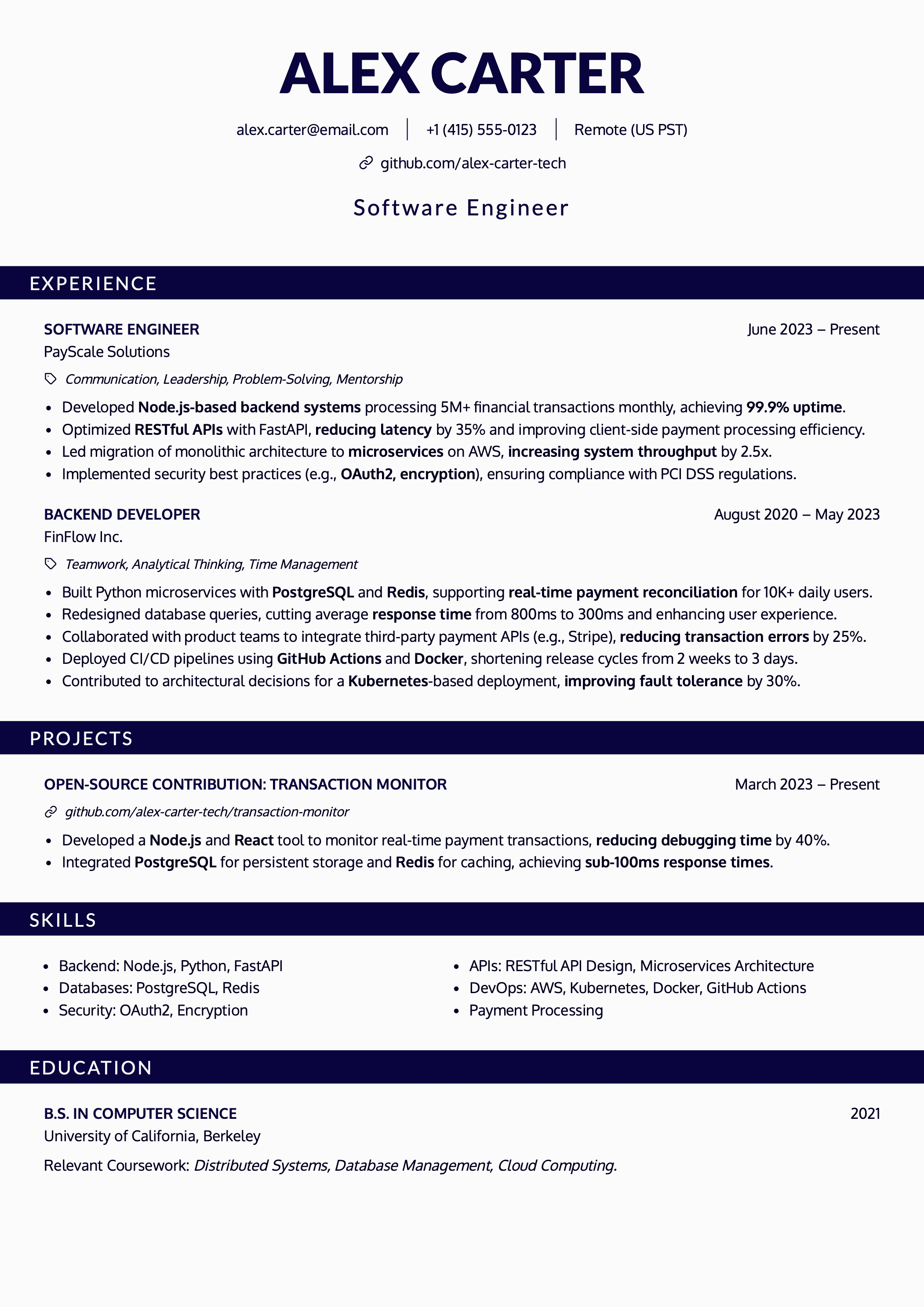
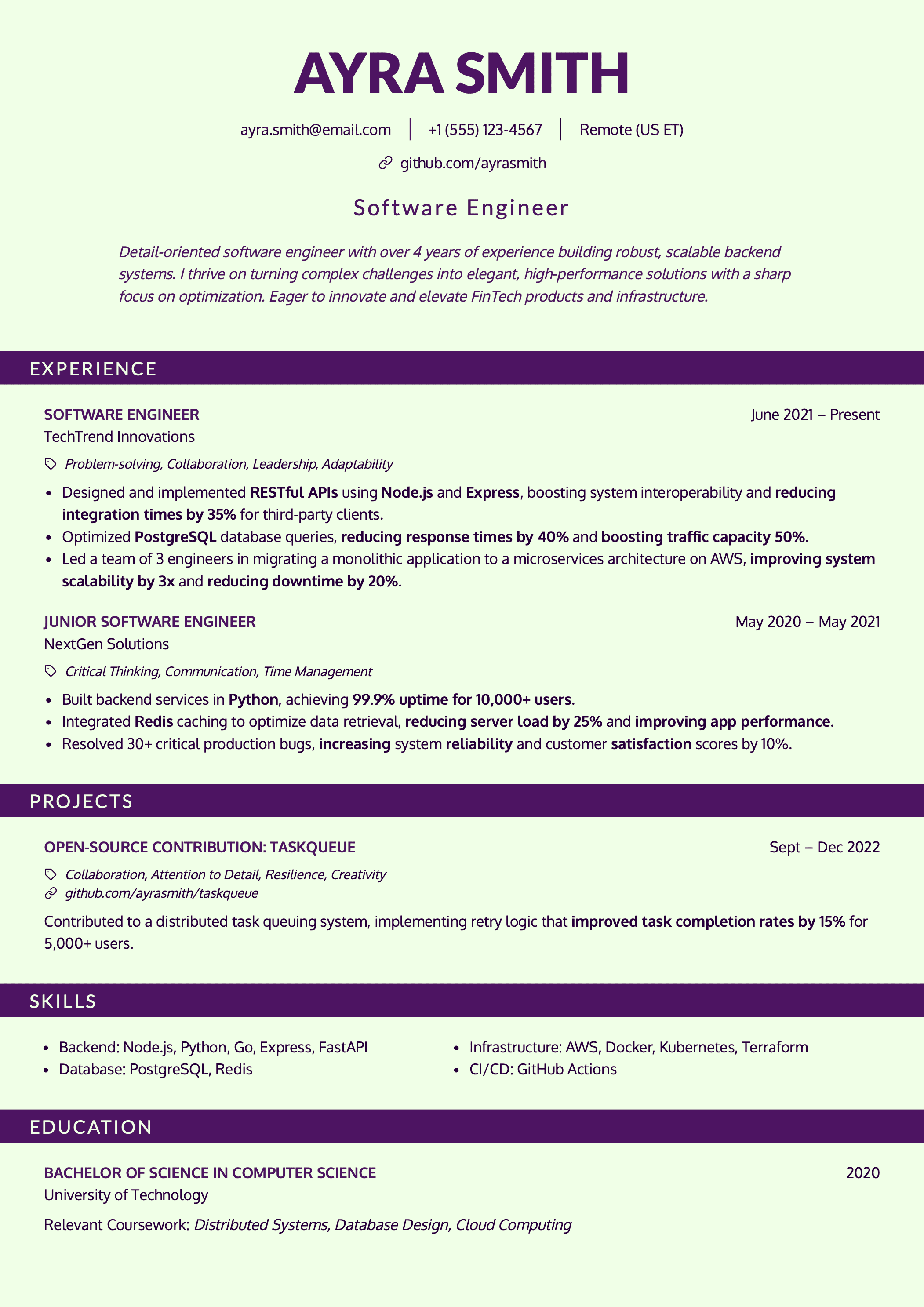
Modern resume template (example for software engineers)
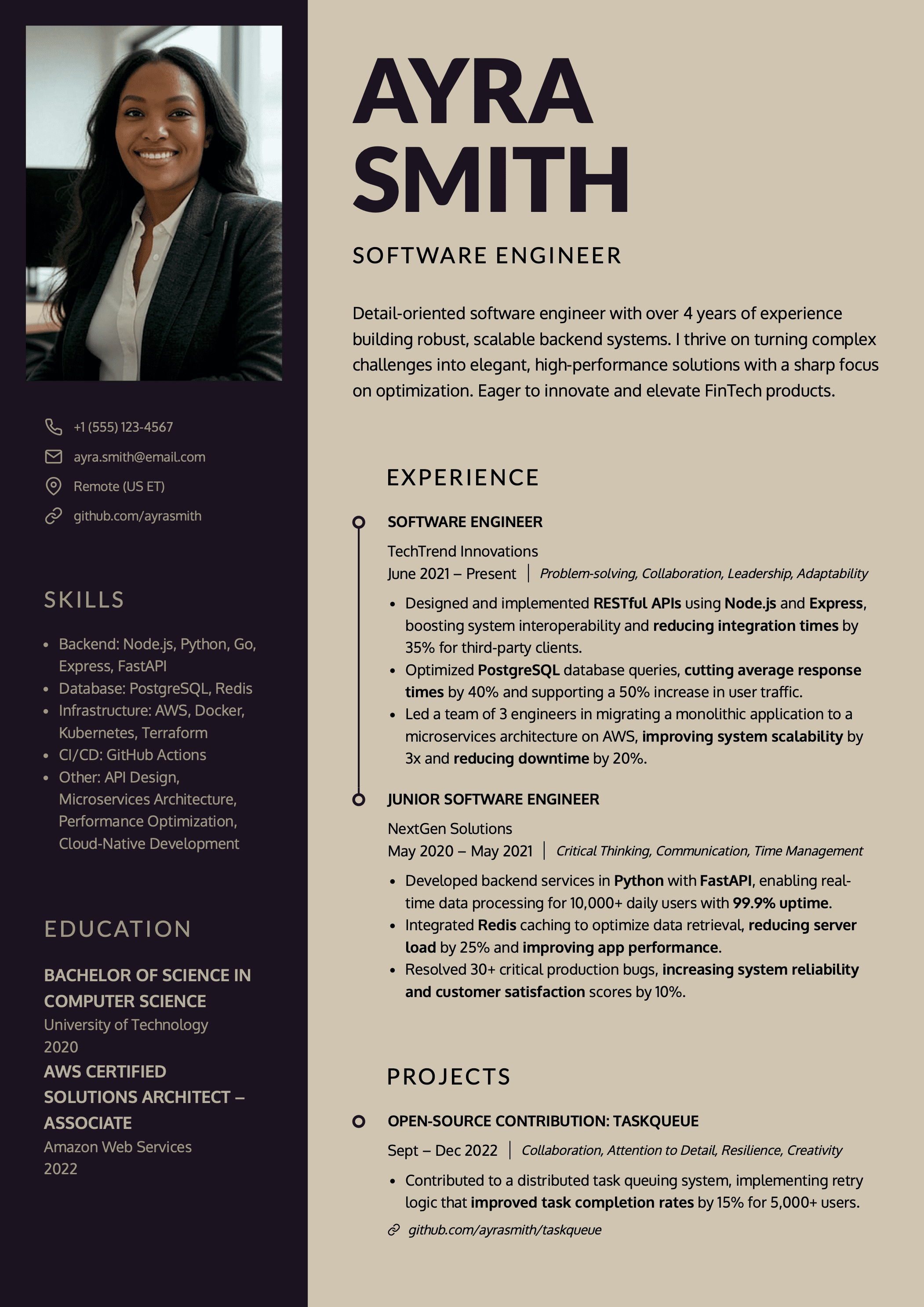
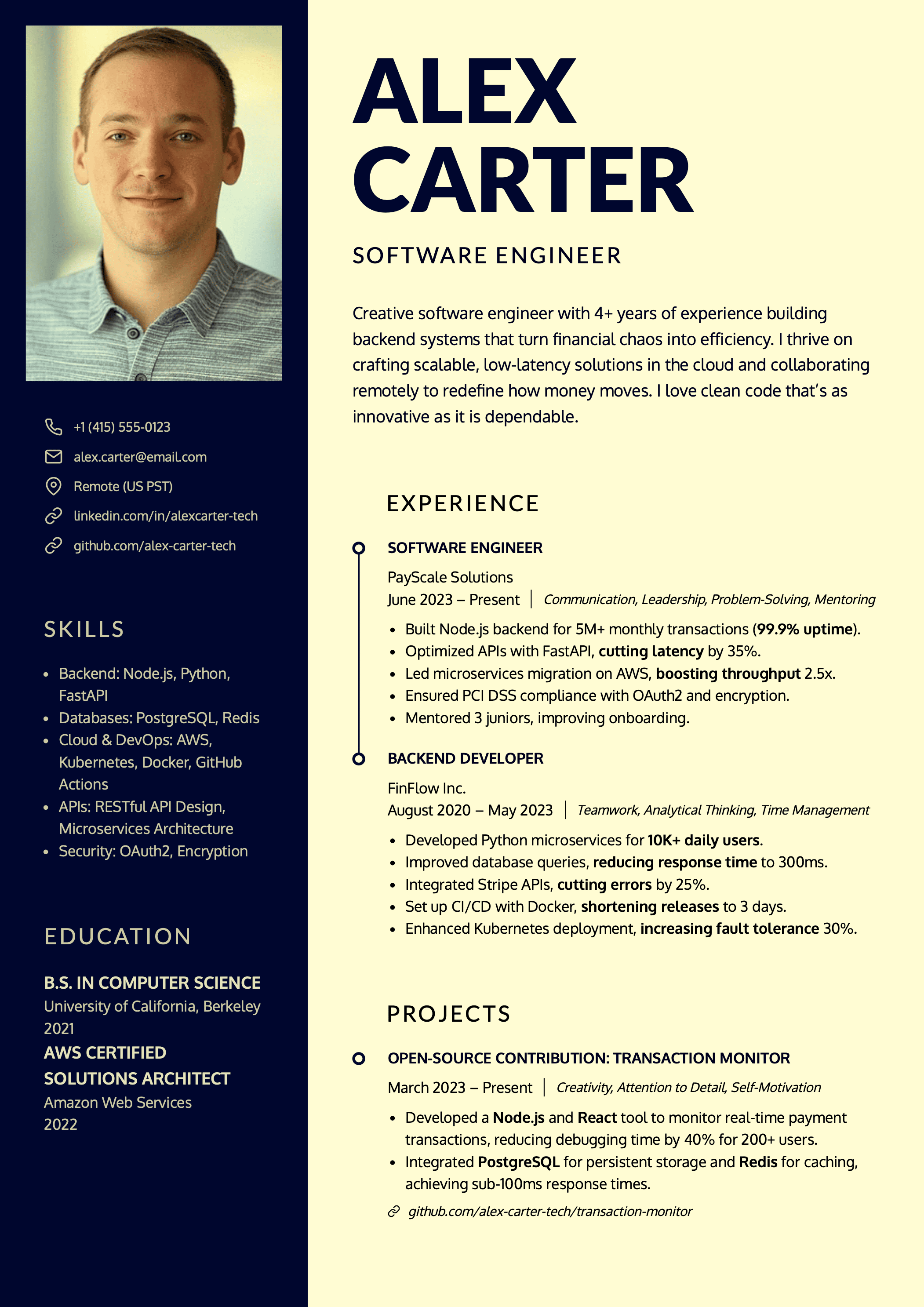
Creative resume template (example for software engineers)
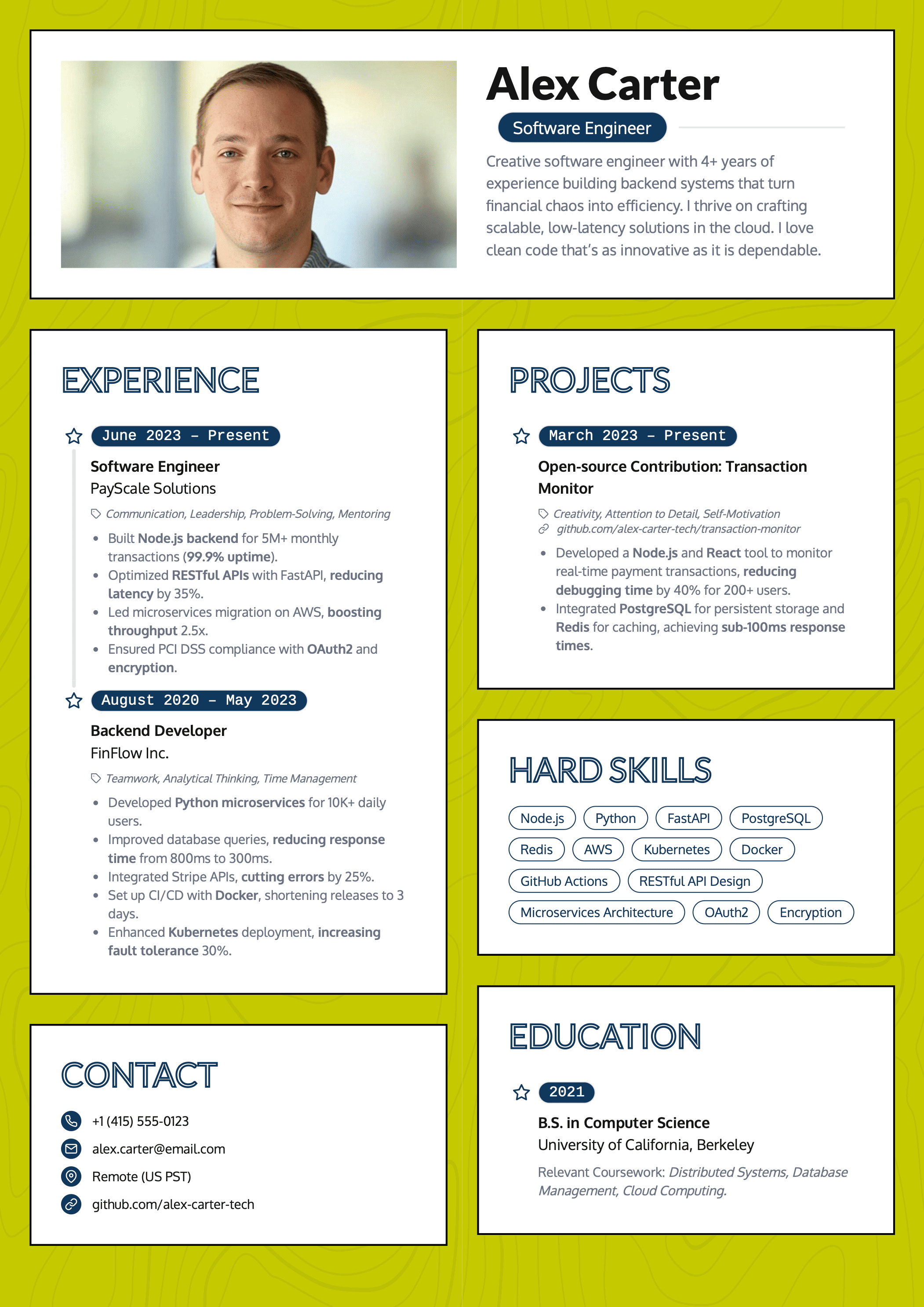

I’ve crafted these resumes using CandyCV.
Why are these great resumes?
Beyond their ATS optimization, these resumes are great storytellers:
- Eye-catching vibes: one-page, clear sections, whitespacing, bolded titles and concise summaries highlight 4+ years, backend optimization and FinTech innovation; grabbing recruiters’ attention fast.
- Action verbs and relevant achievements: they use verbs like “Designed,” “Led” with quantified wins (e.g., “cut response times 40%,” “scaled systems 3x”), proving performance optimization and system scalability as the job asks.
- Tech and job fit: skills match job stack; and transferable API design and database optimization align with FinTech needs despite no direct experience in Ayra’s case. GitHub links (as requested in the job posting) and CS coursework add value and reinforce the job fit.
- Attention to detail: “Remote (US ET)” or “Remote (US PST)”, rather than just writing the city they live in, match the job’s remote-first preference for EU/US time zones.
- Soft skills with soul: they prove problem-solving, teamwork, and leadership through real wins. Project contributions reflect eagerness to learn and technical excellence, just like the job wants.
- Sneak peek into their personalities through the color selection: white and blue shout reliability and confidence, yellow sparks optimism and energy. Bright green is bold and creative. Pink throws in a soft, disarming charm. Light backgrounds keep it fresh and friendly, and dark backgrounds bring a grounded, professional vibe.
I know, it’s easier said than done. What seems obvious when you read it isn’t obvious at all when you have to apply it for your case. If seeing what not to do and comparing examples helps, check out how the same candidates can be rejected simply for having a poorly crafted resume.
Your turn: build a job-winning resume
You have the framework and the resume templates to beat ATS and impress recruiters, now execute it. A resume that lands interviews reflects you: your results, your drive, your edge, your skills, your personality. You’ve got the tools; now trust yourself to use them!
If you’re still reading, I want to thank you. Pass it along if it’s clicked!
Next step: turn what you’ve learned into a resume that gets you in the door!
We're two product builders who care about quality, taste and doing things right. We want you to get that job you want, plain and simple. That's why we are building CandyCV to help you create a great resume and land a job for free. If you give us a try (and feedback!), we'll be forever grateful 😊
Alba Hornero
Co-founder and Product Builder
As CandyCV’s co-founder and a former product lead in HR tech, I’ve built ATS tools, optimized hiring processes, and interviewed hundreds of recruiters. I personally write every post, no AI, no SEO freelancers; just real, high-impact job search advice that truly helps you land your next role.